|
|
|
Sort Order |
|
|
|
Items / Page
|
|
|
|
|
|
|
| Srl | Item |
| 1 |
ID:
167675
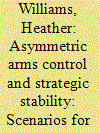

|
|
|
|
|
| Summary/Abstract |
Can arms control incorporate emerging technology? Other articles in this special issue identify potential risks emerging technologies pose to stability and how they are intertwined with international politics. Is there a future for multilateral strategic arms control? This article looks ahead to explore how arms control might reduce those risks but in order to do so we must update concepts of both arms control and strategic stability. Building on Thomas Schelling and Morton Halperin’s seminal study into the relationship between strategic stability and arms control, this article offers an original framework – asymmetric arms control – for incorporating new technologies, which is then used to identify six scenarios for arms control of hypersonic glide vehicles (HGVs). It concludes that arms control can potentially reduce the risks to strategic stability associated with emerging technologies by incorporating dynamism into arms control design. Ultimately, asymmetric arms control can best contribute to strategic stability by crossing domains and reflecting the cross-domain nature of international conflict, and the framework has potential application to emerging technologies beyond HGVs.
|
|
|
|
|
|
|
|
|
|
|
|
|
|
|
|
| 2 |
ID:
167677
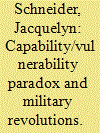

|
|
|
|
|
| Summary/Abstract |
The Information Revolution, or the rise in computing power, allowed states to leverage digital capabilities to exert conventional military dominance. But does it also create vulnerabilities that lead to war? In this piece, I examine the relationship between military revolutions and conflict initiation and identify a capability/vulnerability paradox that suggests the degree of capability dependence created by a military revolution combined with the ability of adversaries to exploit vulnerabilities creates potential pockets of dangerous instability. These indicators suggest that greater centralisation and data dependencies could move the Information Revolution towards incentives for instability.
|
|
|
|
|
|
|
|
|
|
|
|
|
|
|
|
| 3 |
ID:
167676
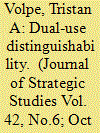

|
|
|
|
|
| Summary/Abstract |
Additive manufacturing is being adopted by nuclear programmes to improve production capabilities, yet its impact on strategic stability remains unclear. This article uses the security dilemma to assess incentives for arms racing as the emerging technology becomes integrated into nuclear supply chains. Innovations sow the ground for competition by making it easier to produce weapons and harder to distinguish civil from military motives. But additive manufacturing could still mature into an asset by revealing greater information about nuclear aspirants. Beyond the nuclear realm, the article refines offense-defence theory to explain how changes in non-military technology shape the practice of deception.
|
|
|
|
|
|
|
|
|
|
|
|
|
|
|
|
| 4 |
ID:
167672
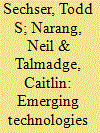

|
|
|
|
|
| Summary/Abstract |
Recent commentary has sounded the alarm about the effects of emerging technologies on strategic stability, yet the topic has received relatively little systematic scholarly attention. Will emerging technologies such as cyber, autonomous weapons, additive manufacturing, hypersonic vehicles, and remote sensing make the world more dangerous? Or is pessimism unwarranted? In this volume, we leverage international relations scholarship, historical data, and a variety of methodological approaches to discern the future implications of new technologies for international security. The findings suggest that new technologies can have multiple, conditional, and even contradictory effects on different aspects of strategic stability, and raise a host of important questions for future research.
|
|
|
|
|
|
|
|
|
|
|
|
|
|
|
|
| 5 |
ID:
167678
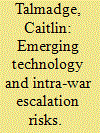

|
|
|
|
|
| Summary/Abstract |
Will emerging technologies increase the risk of conflict escalation? This paper develops a framework for evaluating the role of technology in different types of intra-war escalation. It then uses the framework to probe empirically the possible role of technology in escalation through three carefully chosen cases from Cold War. The findings largely cast doubt on the idea of emerging technologies as an independent, primary driver of otherwise avoidable escalation, suggesting instead that technology more likely functions as an intervening variable – a sometimes necessary, but rarely sufficient, condition for escalation. The conclusion explores the implications of this analysis for the future.
|
|
|
|
|
|
|
|
|
|
|
|
|
|
|
|
| 6 |
ID:
167673


|
|
|
|
|
| Summary/Abstract |
We ask how the offense-defense balance scales, meaning how it changes as investments into a conflict increase. To do so we offer a general formalization of the offense-defense balance in terms of contest success functions. Simple models of ground invasions and cyberattacks that exploit software vulnerabilities suggest that, in both cases, growth in investments will favor offense when investment levels are sufficiently low and favor defense when they are sufficiently high. We refer to this phenomenon as offensive-then-defensive scaling or OD-scaling. Such scaling effects may help us understand the security implications of applications of artificial intelligence that in essence scale up existing capabilities.
|
|
|
|
|
|
|
|
|
|
|
|
|
|
|
|
| 7 |
ID:
167674


|
|
|
|
|
| Summary/Abstract |
While the applications of artificial intelligence (AI) for militaries are broad, lethal autonomous weapon systems (LAWS) represent one possible usage of narrow AI by militaries. Research and development on LAWS by major powers, middle powers and non-state actors makes exploring the consequences for the security environment a crucial task. This article draws on classic research in security studies and examples from military history to assess the potential development and deployment of LAWS, as well as how they could influence arms races, the stability of deterrence, including strategic stability, the risk of crisis instability and wartime escalation. It focuses on these questions through the lens of two characteristics of LAWS: the potential for increased operational speed and the potential for decreased human control over battlefield choices. It also examines how these issues interact with the large uncertainty parameter associated with potential AI-based military capabilities at present, both in terms of the range of the possible and the opacity of their programming.
|
|
|
|
|
|
|
|
|
|
|
|
|
|
|
|
|
|
|
|
|